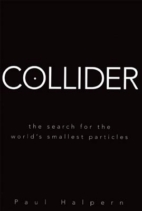by Paul Halpern, Wiley. Hardback ISBN 9780470286203, €24.90 (£18.99, $27.95).

As well as opening a new era of fundamental physics research, the LHC is also making its mark on science publishing. There are already several books on the LHC – soon there will be more. Paul Halpern of Philadelphia’s University of the Sciences is a prolific author and has produced a book aimed at the North American market.
After a tourist’s introduction to CERN, Collider charts the history of the quest to discover and explain the structure of matter. Any book on particle physics has to shoulder this burden. Thus, in a book about 21st-century science, the first illustration is a portrait of Ernest Rutherford.
Unification, as a means to understand as much as possible from a minimal subset of axioms, is a central theme in physics. Halpern points out the aptness of CERN having its home in Switzerland. Just as the country successfully unifies different languages, religions and geographies, so can it be with physics: with imagination and insight, what superficially seems to be highly disparate, in fact reveals deep parallels.
As well as this theoretical understanding, Halpern also traces the history of the particle accelerators that probe the depths of the atomic nucleus and the detectors needed to capture and record their outcomes. After the Second World War, this science became very much a US speciality, with CERN trying to play catch-up as best it could.
With colliding-beam machines providing an additional stage for this research, it was Carlo Rubbia who helped propose the idea of a proton–antiproton collider. However, Fermilab in the US was committed to equipping its ring tunnel with superconducting magnets, so Rubbia knocked on CERN’s door instead.
There, prescient minds saw the value of the scheme. In 1983 came the landmark discovery of the W and Z particles – the carriers of the unified electroweak force (the Nobel path to a unified electroweak theory). With this collider, Europe had not only caught up but overtook the US, where it was a blow to national scientific prestige. As Halpern writes: “Like baseball, accelerator physics had become an American pastime, so it was like losing the World Series to Switzerland.”
Piqued, the US mobilized for the mother of all colliders, its Superconducting Supercollider (SSC). Halpern recalls the SSC era and points out how the machine, primarily a US venture, was handicapped by its limited international horizon.
After the sudden cancellation of the SSC, the less ambitious LHC collider was alone on the world stage and CERN, itself an international organization, knew how to manage such ventures. The SSC had been a green-field site: CERN had the advantage of an existing tunnel, built to house its electron–positron collider, LEP. More credit should be given to the CERN pioneers who had presciently stressed right at the start that this tunnel should be made wide enough to accommodate big magnets for a later, more ambitious machine. Thanks to such foresight, the LHC could fit inside CERN’s existing subterranean real estate.
In 2008 the commissioning of the LHC was overshadowed by a puerile phobia: black holes from the machine would swallow the planet. Halpern creditably blows away such absurdity. It often appears as though the human race is not happy unless it has something to worry about. In 2009 the panic about purported black holes at the LHC seems to have become obscured by other worries.
Collider is timely, instructive and comprehensive. However, its transatlantic view of Europe sometimes gets a little out of focus. With a population of 7600, the thriving French town of Ferney-Voltaire near CERN is not “little touched by modernity”. This “village” gives France the novelty of separate access to Geneva airport, and its proximity to the international scene in neighbouring Geneva has played a key role in the development of French secondary-school education. On a more important historical note, Isidor Rabi may have suggested the idea of what eventually became CERN, but he did not create it.





